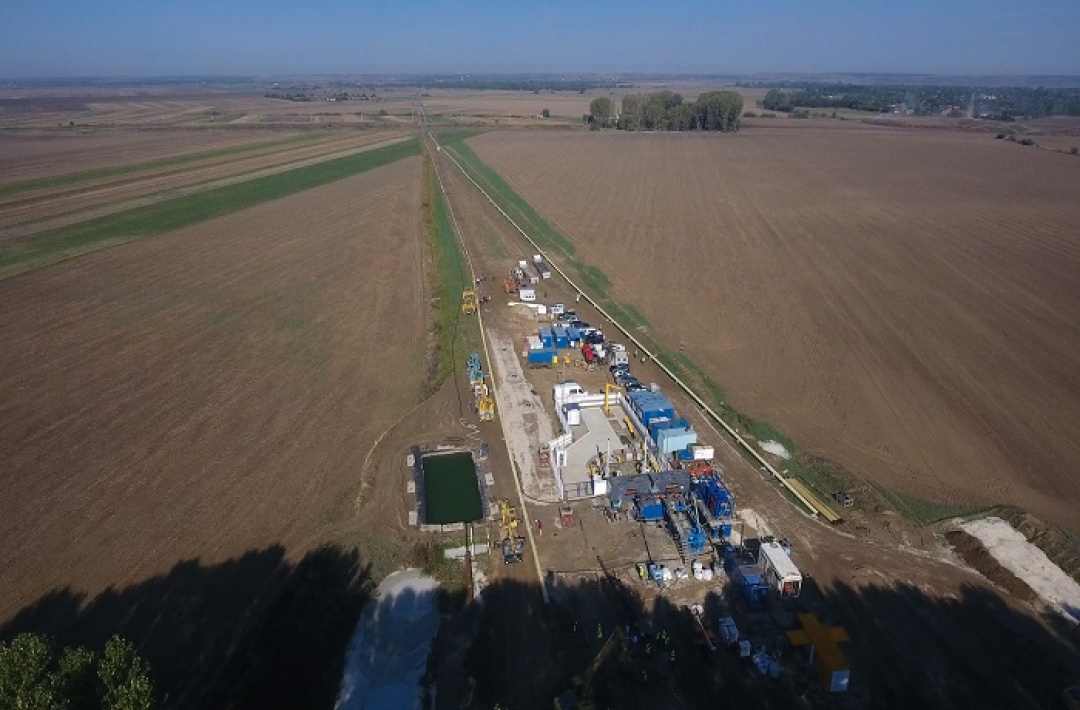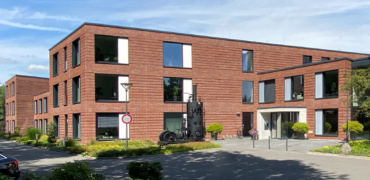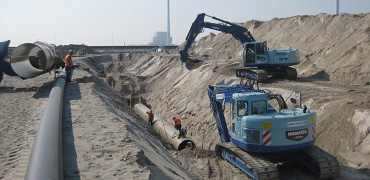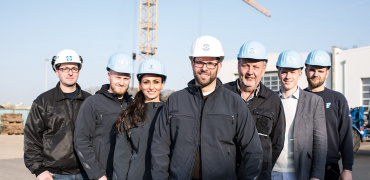Interconnector Bulgaria – Romania / Danube Crossing Marten – Comasca
Some years ago, the Bulgarian and Romanian governments applied with the EU for co-financing to upgrade the existing cross-border gas supply network, resulting from that an invitation to tender was issued in 2011.

 01.12.2016
01.12.2016
That tender focused on the installation of three pipelines below the River Danube between Comasca in Giurgiu County (Romania) and Marten in Ruse County (Bulgaria). These works were aimed at replacing the existing culverts, which were installed by means of open cut method more than 60 years ago, which could only be operated with the low pressure due to their present poor condition.
An EPC contract was set-up to cover the requirement for three horizontal drillings each 2100 m in length, whereby one DN 150 = 6" cable protection pipe and two DN 500 = 20" gas pipes had to be installed, including all secondary work.
The contract for the execution of this work was won in 2012 by a Romanian horizontal drilling company. The 6” line was successfully built. Later, in the first half of 2014 that company had to abandon their efforts as the lack of success on the execution of the drilling work for the first 20“ line had led to them filing for bankruptcy.
Several attempts were then made to find an alternative contractor until the bidding consortium HABAU PPS Romania and INSPET won the contract for the execution and completion of those work. It needs to be noted that the project had to be completed by Christmas 2016, as otherwise EU co-financing would no longer be available.
During the new round of tendering in 2014-2015 LMR had submitted subcontract offers to various companies and were close to being awarded the HDD works but were ultimately not successful. Later, in the spring of 2016, HABAU PPS also requested an offer from LMR and, contrary to expectations, LMR’s offer was accepted and HABAU PPS awarded LMR a subcontract for the execution of HDD drilling work for the two 20" gas pipelines.
One unusual characteristic of this work was that the ground conditions had been inadequately investigated at the time of award. Furthermore, there were rumours that adverse ground conditions had a significant part to play in the failure of the drilling works of the former Romanian drilling contractor. With that in mind, LMR prepared an offer with a drilling concept that covered various foreseeable scenarios and risks. The main assumptions were that the soil was heavily disturbed on the first 120 m along the drilling alignment and that mud losses could be expected on the remaining drilling section. Accordingly, it was proposed to install casing pipes along the first 120 m of the drill alignment and to have a concept for the rest of the drilling, which took into account significant or even total mud losses. The drilling concept also provided just one drill rig for the execution of drilling operations from the Bulgarian side.
After an intensive phase of engineering and planning development for the drilling operations and several coordination meetings with the Main Contractor, the pre-drilling works began in June. This included the installation of 120 m long casings for the start section of both bore holes which was carried out with the support of a specialized sub-contractor. With the drill entry points some 15 m above the river level and the ground level dropping relatively quickly, these casing pipes had the added benefit of providing a safeguard against mud breakouts to surface.
At the same time, a soil investigation campaign took place, covering the entire drill line for both river crossings. This provided 10 core drillings to depths of up to 100 m which became the basis for the development of a comprehensive ground model defining the distribution and juxtaposition of the varying soil types along the route. The results were far from ideal with the river crossings being located at a point where geological conditions were highly unfavourable. Nonetheless, with the connector stations on the Bulgarian and Romanian sides of the Danube already built there was no option to change the crossing point.
The ground on the Bulgarian side was interspersed with localised zones of heavy tectonic disturbance. The rest of the drill line did not prove to be much better, except that the frequency of the disturbed zones reduced from five disturbed zones in the first 200 m to ten further disturbed zones over the remaining 1,900 m. Otherwise, it was clear that more or less fractured limestone with uniaxial compressive strengths of between 30 and 160 MPa (the strength of porcelain) had to be passed through. With these prerequisites, LMR entered the race.
As expected, the casing pipe installation worked well and both casing pipes were completed within five weeks and was followed by the mobilisation of the HDD equipment.
 Picture 02: Jobsite HDD1 View from East to West
Picture 02: Jobsite HDD1 View from East to West
On 2nd July 2016, drilling operations began. Soon, the first disturbed zone was encountered and it came as no surprise when total mud losses occurred immediately. What was a surprise, even to the geotechnical consultants on site, was the speed with which the drilling fluid ran away. This left the drill crew with the impression of having encountered a ‘black hole’ that had swallowed more than 60 m³ of drilling fluid within a few seconds!
The next month was characterized by cementations, which filled and sealed these disturbed loss zones. Cementing equipment and technology originating from the oil field was used on site. In addition, new cement slurry mixes were developed on the construction site, which allowed an even more efficient process for sealing each of these loss zones. In parallel, pilot drilling operations continued.
The frequency of the cementations confirmed the aforementioned, generally negative, findings of the soil investigation campaign. Despite the fact that large volumes of sealing and filling material were pumped downhole, the extremely high frequency of fractures in conjunction with high groundwater flow rates probably explains the rapid removal of the sealing and filling material and the frequency of stops for cementation which came as a surprise to all the involved parties. This led to an undesirable delay in the construction period.
As a result, discussions soon started to consider how to minimise the delays and what could potentially be done to finish the project before the winter break. At the end of July, 40% of the first pilot drill was complete but had already taken 115% of the allotted construction time for that operation. These discussions continued with inputs from all parties. The Client and construction companies stood with their backs to the wall as a construction time analysis made clear that, if everything went well, only the first crossing would just be completed by Christmas 2016. This would have put the EU co-financing at risk.
 Picture 03: Jobsite HDD1 View from West to East
Picture 03: Jobsite HDD1 View from West to East
Eventually, the Main Contractor and Client decided that drilling works were to continue and with full mud losses where necessary. With this being the case, some additional specialist equipment, partially owned by LMR, was mobilised. It was also decided that so as to ensure that the end date could be kept drilling was to continue on a multi shift basis (24 hours, 7 day week). Consequently, the first pilot drilling was completed on 27th August at 23:28 hrs. This was a great relief for all parties with extremely high forces: torque > 80 KNm and push forces > 900 KN required to finish the pilot borehole. This was only feasible using LMR's world-leading drill pipe specification.
Subsequently, the enlargement of the borehole began. However, this had to stop quickly as torque forces acting on the drill string were permanently in the overload range > 90 kNm on the first 10 drill rods (from 215). That created a defect at one of the rotary motors on the drill rig, which was repaired and modified by the drill crew on site. In addition, the borehole was checked with a specially designed drilling tool, developed by LMR. That tool aimed to reduce the forces on the drill string. After the successful check trip with that tool the borehole could be enlarged.
The reaming of a long borehole through rock is a stern challenge as the drill string is a 2100 m long drive shaft for the hole-opener. The handling of the drill tool by the operators was a difficult task as the drill string, over such lengths, tends to twist several times before the drilling tool, a hole-opener, begins to work on the bottom of the borehole. At the same time, in the case of rock drilling, an added risk is that such tools occasionally jam temporarily (for some seconds, before the rock breaks away) – which leads to an even more uneven performance. Risks relating to this include the breaking of drill pipes or the loosening of threaded connections, which then leads to time-consuming rescue or recovery works.
While the drill string was undamaged a situation arose whereby the drill string in the borehole unscrewed due to the aforementioned "slip-stick effect". Fortunately, it proved possible to immediately reconnect the drill string due to the prudent and far-sighted action of the driller. Following this incident, the drill string was again torqued up and then the reaming operations could be successfully completed.
Picture 04: Hope Opener after reaming HDD1
The reaming was followed by a check-trip and another run through the bore hole with a dummy. The dummy-run was to prove that the anti-corrosion coating system could resist the forces which would act on that product during pullback. This was necessary as the GRP coated product pipe for the first crossing had already been laying on site in a prefabricated and unprotected condition for 3 years and tests in the summer of 2016 resulted in at least parts of this coating having to be repaired. The dummy-run showed significant damages to the coating. Despite these negative warning signs, the first product pipe was successfully pulled in consultation and upon request of the beneficiary. A subsequent intensive measurement showed no damage to the insulation system, which was met with great relief.
 Picture 05: Exit point pull back HDD1
Picture 05: Exit point pull back HDD1
With the background of winter working conditions which may have stopped the HDD works, the Main Contractor and Client together with LMR had been discussing the planning of the second crossing throughout the reaming operations on the first drill. The key question was what could be done to accelerate the second river crossing in a quick and reliable manner. These conversations led to an adapted new drilling concept, whereby major parameters are shown hereafter:
- The use of a new, modified drilling assembly and drilling programme.
- Reduction of the length of sections of the bore hole where cementation operations shall take place in case of mud losses.
- Performing a meeting in the middle and to accept the unavoidability of mud losses should they materialise.
- Starting drilling operations as soon as possible on a multiple 24/7 shift basis.
The first pullback was followed by an exhilarating pipe fest and the moving of the drill rig and the preparation, in parallel, of the additional drilling rig on the Romanian construction site near Comasca.
Then the pilot drilling on the second crossing could begin. This was to a great extent free of problems on the Romanian side, until at approx. 1400 m drilling distance the pilot drilling operations were stopped, in order to wait for the "pilot" coming from Bulgaria. Pilot drilling operations, starting in Bulgaria progressed also better than anticipated. Just one cementation (compared to > 8 on HDD1) was required.
One unexpected challenge was encountered when the drill string was strongly deflected at approximately 400 m distance. The formations encountered at that position were unfavourably aligned with respect to the drill alignment, were locally very karstic and showed frequent changes in hardness (soft rock – hard rock = rock lasagne). This required a time-consuming correction of the drill line but after several days the procedure was complete and the meeting (= intersect) could proceed.
To effect the intersect, the Bulgarian pilot passed the Romanian pilot and with the support of specialised borehole surveying tools, the distance between the two steering probes inside the pilot drill assemblies could be determined. Based on this, bore path correction parameters were evaluated and calculated and the pilot drilling could be continued. This process was repeated several times until finally the Bulgarian pilot entered the borehole of the Romanian pilot. This was carried out within the limits of the pre-determined elastic bending radii of the product pipe for the load case “test- pressure”.
Afterwards, the Romanian pilot was quickly tripped out and the Bulgarian pilot was pushed forwards. This worked very well although 80 m before the exit point the Bulgarian pilot drill assembly drifted out of the bore hole in locally occurring soft soils. However, this happened in jettable, soft soils and the rock drilling assembly on the end of the Bulgarian pilot string was used with success in drilling to the Romanian exit point. That "Plan B operation" was not planned but helped in achieving and accessing the target exit-point in Romania.
After the successful completion of the pilot drilling, the bore hole was enlarged. With the experience gained on the first drill, the objective was to avoid the occurrence of high torques on the drill string. To achieve this goal, the drilling rig on the Romanian site was modified by LMR. This resulted in both drill rigs being able to rotate and pull the drill string in the borehole simultaneously. In this manner, the torque on the drill string was reduced from 90 - 100 kNm (HDD 1) to 10 - 65 kNm (HDD 2).
This enabled progress during the reaming of the borehole at a much improved rate with these works taking 10 days to complete, much closer to the original programme. Despite the loss zones encountered during pilot drilling, a special drilling fluid configuration and conditioning enabled mud return flow to be maintained for almost 1,800 m of the hole. In this respect, a great deal of praise to the mud engineers and the team on the mixing tanks that handled those works very well.
After the borehole was reamed, a check-trip was carried out. This was done to ensure that the bore hole was free from obstacles. The check-trip was also used to confirm the forces acting on the drill string during pilot drilling and reaming. These forces were compared with the values of the first crossing, too. The good quality of the bore hole could be confirmed with the check-trip and the pullback could then be carried out with great success with completion within 18½ hours with this final drilling operation complete on 4th November at 17:38 hrs local time, well before the beginning of the winter and to the great pleasure of the Client, the Main Contractor - and to be honest - also to the great relief of LMR.
Result
For LMR, this project was the first big HDD job site in the Balkans. It is not surprising that in Bulgaria and Romania some situations and challenges are assessed differently to Western Europe. The high levels of self-motivation and initiative shown by local partner companies and, in particular, the support from the Local Authorities were a positive surprise. Never giving up hope and constantly asking ourselves the question ‘What can be improved?’ was very important for LMR as was the open exchange of these thoughts with the Client and the Main Contractor. In this context, all changes to the drilling procedures and drilling equipment were proven to be of great benefit.

Picture 06: Pull Back
Project: Danube Crossing – Interconnector
Planning HDD: LMR Drilling GmbH
Client: Bulgartransgaz + Transgaz Romania
Main Contractor: HABAU PPS Romania (together with. INSPET)
Contractor (HDD): LMR Drilling GmbH
Subcontractors: Prime Horizontal for bore hole steering services, HEADS for drilling fluid engineering
Construction period: June 2016 – November 2016
Staff: the complete team of LMR
Equipment: Rig: 3500.180.1 und 2500.120.3 with complete additional equipment (double) and 3000 m drill pipes


